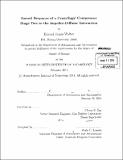Forced response of a centrifugal compressor stage due to the impeller-diffuser interaction
Author(s)
Walton, Edward James
DownloadFull printable version (17.60Mb)
Other Contributors
Massachusetts Institute of Technology. Department of Aeronautics and Astronautics.
Advisor
Choon S. Tan.
Terms of use
Metadata
Show full item recordAbstract
The unsteady pressure field experienced by a centrifugal compressor stage can be dominated by of the impeller-diffuser interaction. The energy of the unsteady field, under certain aerodynamic and structural conditions, is capable of forcing the rotating impeller blades to vibrate excessively to the point of failure, better known as a high cycle fatigue (HCF) failure. This thesis seeks to identify the physical mechanisms that set the forced response amplitude of an impeller due to the impeller-diffuser interaction. The centrifugal stage researched is comprised of a stationary discrete passage diffuser and an unshrouded rotating impeller with both main and splitter blades. The forced response of two splitter blade modes are computed for a variety of structural boundary conditions and unsteady loadings to elicit the driving physical mechanisms. The findings indicate that the forced response is enhanced when the excitation frequency matches a component's natural frequency, the characteristic wavelength of the unsteady loading matches that of the structural vibration mode, the resonance occurs at high speed, and when modal displacement exists at the impeller blade's trailing edge. The findings also suggest that modal coupling of blade and disk dominant modes leads to high sensitivity of the forced response to small variations in airfoil and disk backwall thickness. Identification of blade-disk couplings are described using a simplified SAFE (Singh's Advanced Frequency Evaluation) diagram. The forced response of taut strings, Bernoulli-Euler beams, and a two mass-spring system are also utilized to elicit how the physical mechanisms act on the impeller's forced response. The Bernoulli-Euler beam model suggests that a mismatch of the forcing wavelength to the structural wavelength by 50% will reduce the forced response amplitude by at least 75%. Finally, a decision tree is proposed to assess the relative resonant risk of impeller modes to the diffuser excitation by identifying which of the physical mechanisms may be the dominant driver of the forced response.
Description
Thesis: S.M., Massachusetts Institute of Technology, Department of Aeronautics and Astronautics, 2014. Cataloged from PDF version of thesis. Includes bibliographical references (pages 135-136).
Date issued
2014Department
Massachusetts Institute of Technology. Department of Aeronautics and AstronauticsPublisher
Massachusetts Institute of Technology
Keywords
Aeronautics and Astronautics.